ME370 Students Find End-of-the-Semester Robot Races a Fun Learning Experience
May 9, 2017

ME370 students attach their team's robot to the cable prior to competing.
There was a lot riding on the 36 little robots navigating the ropes stretched across Boneyard Creek for ME 370's final competition. Held just north of the Engineering Building at noon on Wednesday, May 3rd, the contest drew a crowd of interested spectators who vicariously experienced the little robots' ups and downs, "oohing" and "aahing" during the spectacle. For the students, the contest not only motivated them to show off their engineering prowess; it got their competitive juices flowing as they sought to beat the socks off their opponents. And as an added incentive, teams whose robots beat the time set by Professor Socie's robot got to skip the upcoming final exam.
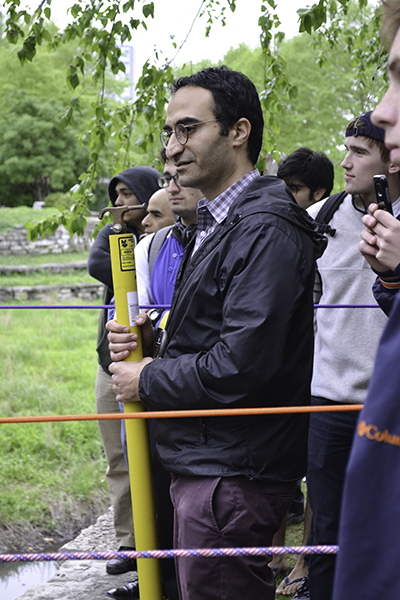
Professor Sam Tawfick (center) watches the competition. The hooked yellow pole he's holding was used on several occasions to rescue robots that got stranded during their crossing.
To test students’ skills acquired over the semester, plus to add some zest to an oftentimes tedious round of final exams, MechSE Assistant Professors Sameh Tawfick, Arend van der Zande, and Professor Emeritus Darrell Socie came up with a final competition for the Spring 2017 edition of ME370, Mechanical Design I, that was a bit more unique than last year’s, which involved building a robot that navigated in a fashion similar to Star Wars’ Imperial Walkers. For this year’s competition, robots were to traverse a rope strung across Boneyard Creek as quickly as possible, without stalling, requiring assistance or a restart (which would get points deducted), or worst-case scenario, getting a dunking in the creek.
To make the project even more fun, instructors used a new-and-improved Star Wars scenario:
“The Empire has set up a secret base for death star research on the mega-jungle world of Costa. Because of the enormous and dense foliage reaching miles high, an attack from the sky or ground is impossible. The rebel alliance is planning a surprise attack by sneaking in on camouflaged walkers that must hang from the vines. In order to prototype new vehicles, the Rebel Alliance turns to their top-secret machine design lab on the prairie world of Chambana…”
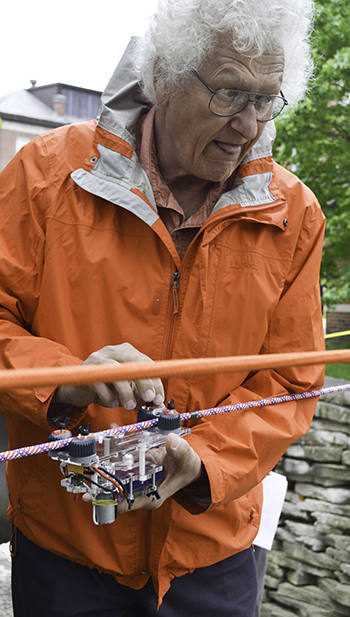
Professor Darrell Socie attaches his walker to the cable.
To make the project even more challenging, robot designs were to be biomimetic or xenobiomimetic —students were to borrow designs from nature. In other words, their robots were to emulate a specific creature’s method of locomotion—i.e., walk like a sloth, swing like a monkey, hang like a bat, crawl like a lizard, slither like a snake, or trellaumph like a Costanian Kryshyk. (It appears that the instructors were having a bit too much fun here—Google has no record of a Costanian Kryshyk. They obviously invented this one as an example of xenobiomimetic!) The scenario also specified that robots were to look like the creatures they were mimicking: “Since this is a surprise attack, the walkers should be camouflaged so that they will pass for the creatures they are imitating under cursory inspection.”
Students had around six weeks to build their projects, which included all the design process stages from concept, to detailed design, to prototype, to the competition. Plus, multiple reviews kept students on track.
To prepare students for the final project, the first half of the semester students were assigned two mini projects.
”In the first, a user-focused design project, students designed pull toys. We had the students thinking about and performing exercises on understanding who they were making the pull toys for and engaging in the creative and empathic side of the product design process,” van der Zande explains.
In the second mini project, students were to design simple mechanisms that performed a specific motion. This “pushed the students to understand the technical aspects of actually building a mechanism and the differences between how an ‘ideal’ mechanism looks on paper or on a computer versus all the complexity that comes up in manufacturing objects in the real world.” For the final project, students were to combine these two different ways of thinking.
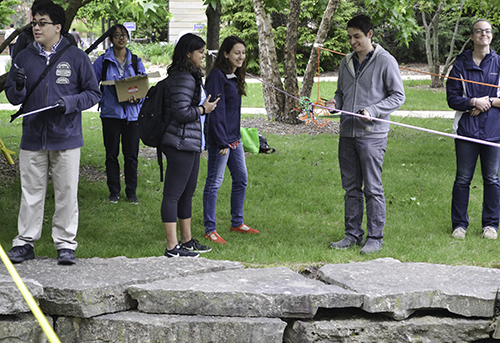
The team in the center waits to retrieve their robot, which has just successfully crossed the Boneyard.
Part of a MechSE course sequence that teaches students design thinking, ME370 helps students learn the fundamental principles of operation for machines and mechanisms (which can include everything from clocks, to bicycles, to sewing machines).
“Each year from freshmen to seniors,” van der Zande explains, “we have students engage in more and more complicated design tasks, where they go through the process of applying the fundamental principles that they learn to actually building a working machine that can accomplish a set task.”
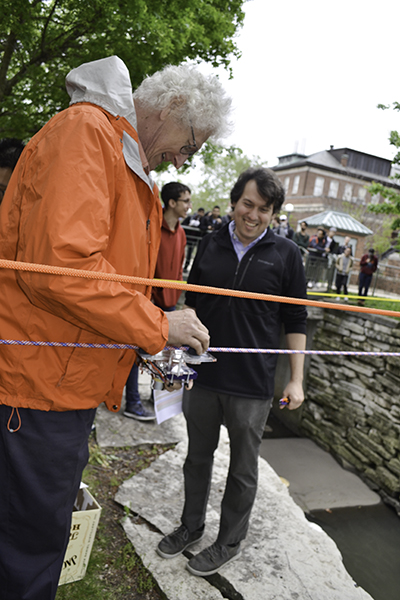
Professor van der Zande (right) watches as Professor Darrell Socie (left) begins his robot's run across the Boneyard. According to Socie, he used a robot of medium speed, hoping that at least 10 or so teams would top his robot's speed.
He goes on to explain that the idea behind this semester’s project is for students to “apply the rigorous technical considerations of designing machinery in order to succeed while being open ended enough to allow them to engage their creative side and come up with many different and unique designs.”
Why a competition? “It really engages the students much more,” reports van der Zande, and “gets them thinking about what they can do to improve their design and win, and not just aim for the minimum they can accomplish to get an A in the class.” He claims students really get into the design process. They “start working late nights in the innovation studio for weeks before the competition to perfect their robots.”
For many students, the course is one of the highlights of their career at Illinois:
“Many of our students from last year have come back to me and said that this was their favorite project during their undergraduate education,” says van der Zande. “For most of those students, they say that this project embodies what they really love about mechanical engineering, and why they got into the major in the first place.”
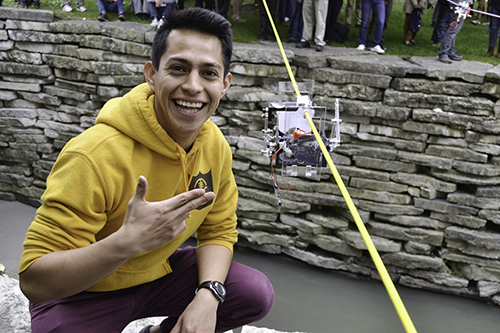
Above: MechSE junior Edgar Mejia watches as his robot competes in the contest.
Below: Mejia's robot traverses the Boneyard.
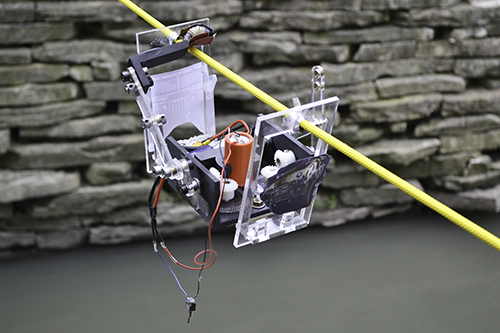
What did the students learn from the project? MechSE junior Edgar Mejia, who hopes to someday have his own company developing technology and manufacturing processes with a sustainability focus, indicates that the main challenge he and his teammates encountered was “assembly due to the tolerance in the different parts. An actual robot is somehow different than the theoretical model."
Mejia reports that in addition to learning things about mechanical engineering, he also grew personally: “First of all, it showed me the importance of collaborating in a big project like this. I believe this skill is very important for the professional world. In terms of engineering, I learned that we need to design with certain allowance for failure.”
Kaleb Kuan, a junior in MechSE, reports that in one of its earlier stages, their robot “was having trouble maintaining stability. As it traversed the rope, its movement would cause rotation about the yaw axis and ultimately one of its 'hands' would end up missing the rope. This meant that we had to design better ‘hands’ that would keep the robot from rotating.”
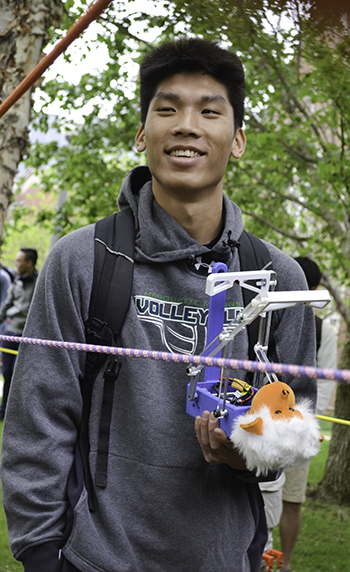
MechSE engineering student Kaleb Kuan prepares to attach his team's robot in order to compete. Based on its camouflage, their robot obviously was emulating a monkey's style of locomotion.
One concept Kuan learned during the project was that of simplicity. “There were numerous groups that had significantly more complex mechanisms and designs that performed at probably less than half the speed of our robot. To be honest, when my group was designing our robot, we weren't really concerned with the complexity or novelty of the mechanism, we just wanted something that would work and would work effectively. When this project shifted from the design stage to the prototyping stage, I started to see that in reality, less was actually more.”
Kuan adds that, “Studying at Illinois has been a tremendous experience full of incredible surprises. In my opinion, having the opportunity to be a student here means that I am gaining expertise and learning problem solving skills that will not only equip me for my future career, but for life in general!”
What’s his future career? Kuan says he doesn’t quite have his career plans figured out yet. “What I do know,” he admits, “is that whatever I end up doing, I want it to be something that benefits or helps those in need.” Whatever he ends up doing he hopes for “the opportunity to bless others.”
So were any of the robots faster than Darrell Socie's, thus the students on those teams got out of taking the final? It turns out that eight teams beat Socie’s time. According to van der Vande, the fastest robot, which emulated the walking motion of a sloth, crossed the Boneyard in 19 seconds!
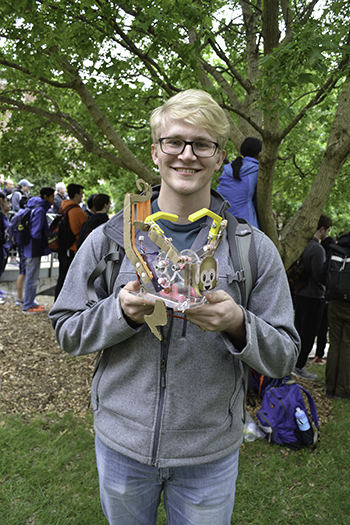
A MechSE engineering student shows off his team's design, another robot that emulated a monkey's style of locomotion.
Kuan’s team was one of the eight. Was he excited to not have to take the final? Yup. But he says he found the process rewarding on a number of levels. “In addition to being exempt from the final exam for beating the professor's robot, I think that one thing I gained was a boost in my overall appreciation for engineering. It's always extremely uplifting when you are able to overcome a task or challenge using both engineering and problem-solving skills!”
Story and photographs by Elizabeth Innes, Communications Specialist, I-STEM Education Initiative.
Other media about the event
- MechSE's video of the walkers:
- Team 4's video about their robot and the construction process.
- Another student video
- ME370's Drench-Your-Professor Competition Creates a Splash
- ME 370's Unique "Drench Your Professor" Competition Hones Students' Design Skills
For I-STEM articles on previous ME370 competitions, see:
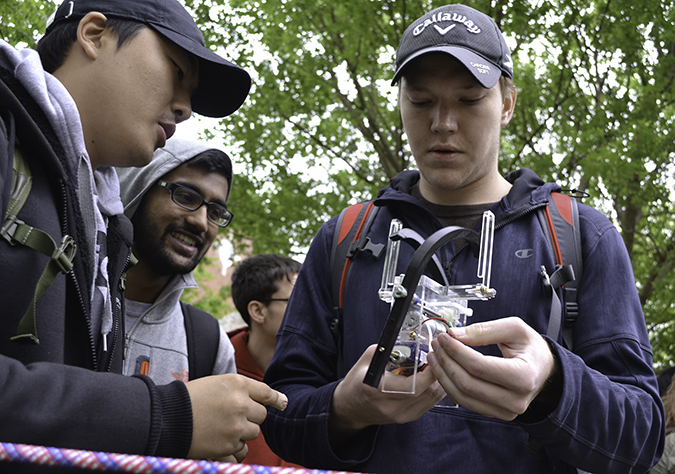
A team of ME 370 students trouble shoot on their robot.













.jpg)
















